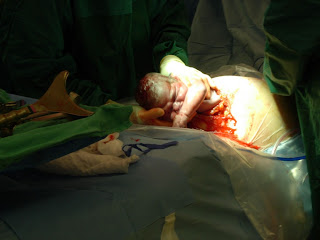 There has been a lot of attention given lately to the increase in Caesarean births. More women are choosing to schedule the day the baby is born over waiting for their water to break.
There has been a lot of attention given lately to the increase in Caesarean births. More women are choosing to schedule the day the baby is born over waiting for their water to break.
The word is out that labour isn’t fun so some new moms are electing to undergo surgery rather than sit through hours of contractions.
The British Journal of Obstetrics and Gynaecology, found that the rise could not be explained by increases in clinical reasons for caesareans such as complications in pregnancy or labour/delivery and was more likely due to societal factors.The research project looked at all births in Western Australia between 1984 and 2003 (more than 430,000 births) and analysed the mode of delivery. It excluded multiple and breech births.
Report author, Colleen O’Leary, from Perth’s Telethon Institute for Child Health Research, said that even after adjusting for pregnancy and delivery complications and sociodemographic factors, the increases were significant. Women in 1999-03 were twice as likely to have a caesarean section, than women in 1984-88.
“The figures show that what we call elective or planned caesareans have risen from 6 per cent to 13 per cent over the 20 year period and during the same time, there has been a 70 per cent increase in the number of emergency caesareans,” Ms O’Leary said.
“From the analysis it is clear that both maternal age and affluence are factors in the increasing rates of caesareans.
“When we included private medical insurance into the analysis, we found that women who had medical insurance were more than three times as likely to have an elective caesarean section, and 1.34 times more likely to have an emergency c-section than those who were uninsured, even though pregnancy complications and obstetric problems which may need a caesarean section are higher in uninsured women.
“The increase in caesarean rates also has a significant impact on health costs in both the public and private sectors.”
Report co-author, obstetrician Craig Pennell from the School of Women’s and Infants’ Health at the University of Western Australia, said the changes over the 20 year period in both elective and emergency caesarean suggest that they are the result of common unmeasured factors acting throughout the whole community.
” The reasons are likely to be multifactorial and reflect a complex social process affected by clinical status, obstetric practice and training, family and social pressures, the legal system, availability of technology, women’s requests and women’s role models, such as celebrity elective caesarean delivery,” Dr Pennell said.
“The degree to which maternal request accounts for the increase in caesarean sections isn’t known, but similar studies in the UK have shown that maternal request is now the fifth most common reason for performing a caesarean section.”
Dr Pennell said that despite improvements in surgical and anaesthetic techniques, a number of studies show that caesarean sections are still associated with an increased risk of maternal and infant death and health complications.
“These data illustrate how a medical intervention that is effective when applied to an appropriately selected case can have significant adverse effects when applied to a low risk population.
“Caesareans are not without risk for mothers or babies, and should be based on solid medical reasons to ensure the best outcome.”
In the most recent five year period, spontaneous vaginal births had dropped by 5 per cent, while forceps and vacuum assisted deliveries were down by 15 per cent.
Labour and delivery is not easy, but neither is motherhood.
Caesarean is a major surgery that is serious with recovery times between 1 -3 weeks as opposed to 1-2 days for a vaginal birth.
I would rather be in discomfort for 24 hours during labour than have to recover for a couple of weeks with scar tissue.






